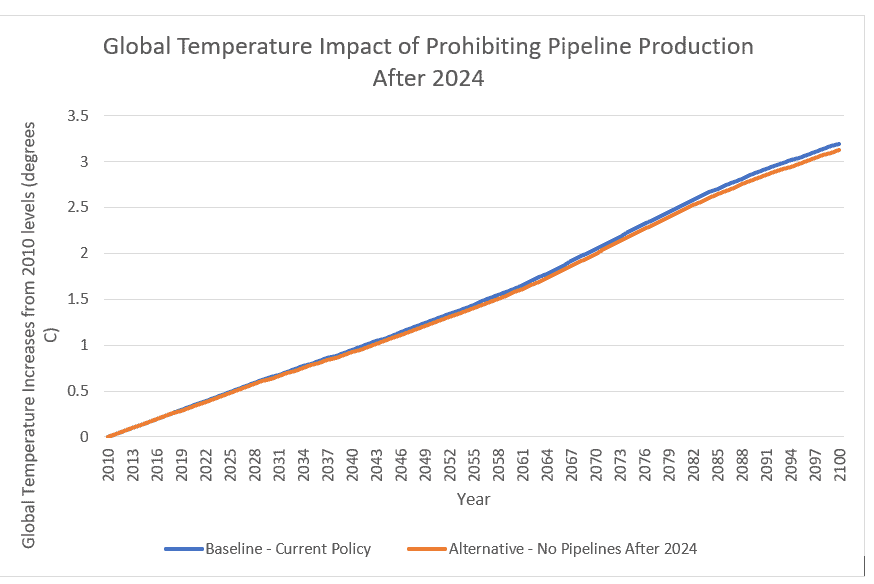CEI Comments Explain Why FERC’s Greenhouse Gas Regulatory Policy Cannot Pass a Cost-Benefit Test

Photo Credit: Getty
Today, the Competitive Enterprise Institute (CEI) filed comments on the Federal Energy Regulatory Commission’s (FERC) proposal to consider climate change impacts in reviews of infrastructure projects under the Natural Gas Act (NGA). The comments were jointly submitted by my CEI colleague Patrick Michaels; Heritage Foundation Chief Statistician, Data Scientist, and Senior Research Fellow Kevin Dayaratna (commenting as an independent scholar rather than as a representative of any organization); and yours truly.
We submitted comments back in January on FERC’s November 2021 technical conference on the same issues. We advised FERC to steer clear of climate policy, for three main reasons.
First, the Biden administration’s NetZero agenda to decarbonize and degasify the U.S. electric power sector cannot lawfully be aligned with the Natural Gas Act. Biden’s goals conflict with the NGA’s “principal purpose,” which is to “encourage the orderly development of plentiful supplies of electricity and natural gas at reasonable prices.” In addition, climate change is not a factor Congress authorized FERC to consider. The words “climate,” “carbon,” “greenhouse,” “global,” “warming,” “mitigate,” or any of their cognates do not occur in the Act.
Second, although the direct and indirect emissions of natural gas infrastructure may be “reasonably foreseeable,” the climate effects are not. FERC’s project reviews are governed by the National Environmental Policy Act (NEPA), which requires scrutiny of major federal actions “significantly affecting the human environment.” Even the emissions of the largest natural gas projects are too small to discernibly affect global climate, and no project’s “carbon footprint” is big enough to influence the fate or fortunes of any community, business, or human being anywhere in the world.
Third, the social cost of carbon (SCC)—an estimate of the present value of the cumulative climate damages of an incremental ton of carbon dioxide equivalent (CO2e) greenhouse gas (GHG) emissions—is too speculative and subjective, and too easily manipulated for political purposes, to be weighed in the same scales with an infrastructure project’s estimated economic benefits. The Biden administration’s SCC estimates are egregiously biased in favor of climate alarm and regulatory ambition, rendering any agency action that relies on them arbitrary and capricious.
Unsurprisingly, FERC did not take our advice, and proceeded in February to adopt an “interim” policy statement on NGA project review and greenhouse gas (GHG) emissions. That stirred up controversy, including pushback by Senate Energy and Natural Resources Chairman Joe Manchin (D-WV) and Ranking Member John Barrasso (R-WY). As a result, FERC in March demoted its GHG policy statement from “interim” to “draft,” and extended the comment period until today, April 25.
Unlike several presenters at FERC’s November 2021 technical conference, the draft GHG policy statement does not advocate requiring SCC analysis in NGA determinations of public convenience and necessity. Neither, however, does FERC disavow an intent to require it in later policy statements. The Commission may simply be waiting for the Biden administration’s Interagency Working Group (IWG) to finalize its interim SCC estimates, or for courts to resolve Louisiana’s challenge to federal agencies’ use of those metrics.
The Commission’s draft GHG policy statement establishes a “rebuttable presumption that proposed projects with 100,000 metric tons per year of carbon dioxide equivalents (CO2e) emissions will be deemed to have a significant impact on climate change.” FERC also implies that it may condition project approval on the sponsor’s plans to “mitigate all or a portion of the project’s climate change impacts.”
The camel’s nose is already under the tent. It is not hard to guess where this is going if FERC does not quickly reverse course. The usual suspects will pressure the Commission to: (1) progressively lower climate significance thresholds, (2) monetize undetectably small project-related climate “impacts” using agenda-driven SCC estimates, and (3) either reject needed natural gas infrastructure projects outright or impose mitigation requirements that render them uneconomic.
This is bad policy, as Michaels, Dayaratna, and I explained in our Januray 7 comments. If an infrastructure project is commercially viable and helps ensure plentiful supplies of electricity and natural gas at reasonable prices (the NGA’s principal purpose), the Commission knows in advance that the project’s economic benefits far exceed its climate-related externalities. Therefore, no further investigation of the project’s GHG emissions is required, nor does it make sense to condition the certificate of public convenience and necessity on the project’s adoption of mitigation measures.
Worse than We Thought
New research by Dayaratna (hereafter “Heritage analysis”) further confirms that conclusion. Using the U.S. government’s leading energy and climate policy models, the Heritage analysis demonstrates that banning construction of new U.S. pipelines would have a negligible effect on U.S. annual CO2 emissions through 2050 and, thus, a similarly negligible effect on global temperatures through 2100. The policy implication for FERC is clear. No level of overregulation or prohibition that regulators might apply to the development of U.S. natural gas pipelines could meaningfully affect the Earth’s climate. Consequently, no regulation or prohibition of new natural gas pipelines could possibly be worth the economic losses imposed on construction companies, natural gas producers, and energy consumers.
Economic Pain for No Climate Gain
The Heritage analysis is based on the federal government’s own data. One of the side cases in the Energy Information Agency’s (EIA) Annual Energy Outlook 2022 (AEO 2022) assumes that no additional interstate natural gas pipelines will be built between 2024 and 2050. Compared to the reference case, the side case projects 4.6 percent less natural gas production, 4.3 percent less natural gas consumption, and Henry Hub prices 11 percent higher in 2050.
The following chart, based on AEO 2022 data, depicts carbon dioxide emissions from fuel consumption in the reference case and the no-pipeline-construction case:

As the above chart illustrates, eliminating pipeline construction reduces U.S. annual CO2 emissions by less than 0.74 percent through 2050.
Dayaratna took those emissions forecasts and simulated the associated temperature impacts using the Model for the Assessment of Greenhouse Gas Induced Climate Change (MAGICC version 6). He assumed a climate sensitivity of 4.5°C (the upper end of the IPCC’s estimates of this metric) and used Representative Concentration Pathway 6.0 as the baseline emission scenario. Upon adjusting fossil-fuel CO2 emissions for the United States in accordance with the upper bound of the EIA’s CO2 reductions, he found the following temperature differences:

The Heritage analysis projects temperature reductions of 0.034°C by 2050 and 0.069°C by 2100 compared to the reference case. Those mitigations are smaller than the margin of error (0.08°C) for estimating annual global average surface temperature. Moreover, the Heritage analysis almost surely overestimates the temperature impacts of a national ban on pipeline construction, for three reasons. The analysis assumes a climate sensitivity that is likely larger than the planet’s actual sensitivity. It assumes the maximum level of CO2 reductions suggested by the EIA’s simulations. It begins the MAGICC simulations in 2020—four years earlier than in the EIA side case.
Conclusion
The Biden administration declares climate change to be a “global crisis,” “planetary emergency,” and “existential threat.” FERC is an independent agency and to our knowledge has not officially endorsed those characterizations. There are powerful reasons to reject climate catastrophism.
Nonetheless, whatever one’s views about the magnitude and certainty of climate change risks, everyone should be able to agree that two things are important to know about any climate change policy: How much will it cost, and how much global warming will it avert?
The Heritage analysis demonstrates that prohibiting natural gas pipelines, which goes beyond any measures FERC has proposed for public comment, would have no detectable impact on global temperatures—hence none on weather patterns, crop yields, polar bear populations, or any other environmental condition people care about. The climate “benefits” of FERC’s proposal would be even more miniscule.
In contrast, the regulatory burdens and litigation risks created by the proposal could impose significant costs on construction companies, natural gas producers, and U.S. energy consumers. FERC’s draft GHG policy thus cannot pass a cost-benefit test.